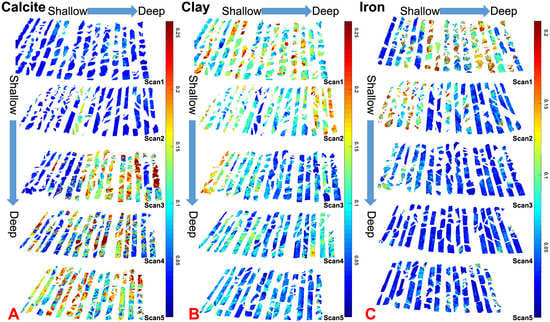Integrated Hyperspectral and Geochemical Study of Sediment-Hosted Disseminated Gold at the Goldstrike District, Utah
Abstract
:1. Introduction
Geological Settings
2. Materials and Methods
2.1. Hyperspectral Imaging
2.2. Geochemistry
3. Results
3.1. Hyperspectral Imaging
3.2. Geochemistry
4. Discussion
4.1. Gold Mineralization in Carlin-Type Deposits
4.2. Stratigraphic Control
4.3. Mineralogical Alterations
4.4. Implications
5. Conclusions
Supplementary Materials
Author Contributions
Funding
Acknowledgments
Conflicts of Interest
References
- Cline, J.S.; Hofstra, A.H.; Muntean, J.L.; Tosdal, R.M.; Hickey, K.A. Carlin-type gold deposits in Nevada: Critical geologic characteristics and viable models. Econ. Geol. 100th Anniv. Vol. 2005, 451–484. [Google Scholar] [CrossRef]
- Muntean, J.L.; Cline, J.S.; Simon, A.C.; Longo, A.A. Magmatic-hydrothermal origin of Nevada’s Carlin-type gold deposits. Nat. Geosci. 2011, 4, 122–127. [Google Scholar] [CrossRef]
- Gu, X. Turbidite-Hosted Micro-Disseminated Gold Deposits; Chengdu University of Science and Technology Press: Chengdu, China, 1996. [Google Scholar]
- Ashley, R.P.; Cunningham, C.G.; Bostick, N.H.; Dean, W.E.; Chou, I.M. Geology and geochemistry of three sedimentary-rock-hosted disseminated gold deposits in Guizhou Province, People’s Republic of China. Ore Geol. Rev. 1991, 6, 133–151. [Google Scholar] [CrossRef]
- Xia, Y.; Su, W.; Zhang, X.; Liu, J. Geochemistry and metallogenic model of carlin-type gold deposits in southwest Guizhou province, China. In Geochemistry-Earth’s System Processes; Panagiotaras, D., Ed.; InTech: Rijeka, Croatia, 2012; pp. 127–156. [Google Scholar]
- Percival, T.J.; Radtke, A.S. Sedimentary-rock-hosted disseminated gold mineralization in the Alsar district, Macedonia. Can. Mineral. 1994, 32, 649–665. [Google Scholar]
- Staude, J.M.G. Epithermal Mineralization in The Sierra Madre Occidental, and the Metallogeny of Northwestern Mexico. Ph.D. Thesis, University of Arizona, Tucson, AZ, USA, 1995. [Google Scholar]
- Krahulec, K. Sedimentary rock-hosted gold and silver deposits of the Northeastern Basin and Range, Utah. Gt. Basin Evolut. Metallog. Geol. Soc. Nev. Symp. 2010, 1, 31–62. [Google Scholar]
- Emsbo, P.; Hutchinson, R.W.; Hofstra, A.H.; Volk, J.A.; Bettles, K.H.; Baschuk, G.J.; Johnson, C.A. Syngenetic au on the carlin trend: Implications for carlin-type deposits. Geology 1999, 27, 59–62. [Google Scholar] [CrossRef]
- Willden, R.; Adair, D.H. Gold deposits at Goldstrike, Utah. In Thrusting and Extensional Structures and Mineralization in the Beaver Dam Mountains, Southwestern Utah; Griffen, D.T., Phillips, W.R., Eds.; Utah Geological Association: Salt Lake City, UT, USA, 1986; pp. 137–147. [Google Scholar]
- Gustin, M.M.; Smith, M.T. Technical Report on the Goldstrike Project, Washington County, Utah, U.S.A.; Technical Report No.; Mine Development Associates: Reno, NV, USA, 2016; pp. 1–106. [Google Scholar]
- Willden, R. Goldstrike mining district, Washington County, Utah. In Mining Districts of Utah; Bon, R.L., Gloyn, R.W., Park, G.M., Eds.; Utah Geological Association: Salt Lake City, UT, USA, 2006; pp. 458–476. [Google Scholar]
- Dalm, M.; Buxton, M.W.N.; van Ruitenbeek, F.J.A. Discriminating ore and waste in a porphyry copper deposit using short-wavelength infrared (SWIR) hyperspectral imagery. Miner. Eng. 2017, 105, 10–18. [Google Scholar] [CrossRef]
- Gallie, E.A.; McArdle, S.; Rivard, B.; Francis, H. Estimating sulphide ore grade in broken rock using visible/infrared hyperspectral reflectance spectra. Int. J. Remote Sens. 2002, 23, 2229–2246. [Google Scholar] [CrossRef]
- Kruse, F.A.; Bedell, R.L.; Taranik, J.V.; Peppin, W.A.; Weatherbee, O.; Calvin, W.M. Mapping alteration minerals at prospect, outcrop and drill core scales using imaging spectrometry. Int. J. Remote Sens. 2012, 33, 1780–1798. [Google Scholar] [CrossRef]
- Riaza, A.; Müller, A. Hyperspectral remote sensing monitoring of pyrite mine wastes: A record of climate variability (Pyrite Belt, Spain). Environ. Earth Sci. 2010, 61, 575–594. [Google Scholar] [CrossRef]
- Adair, D.H. Structural Setting of the Goldstrike District, Washington County, Utah. In Thrusting and Extentional Structures and Mineralization in the Beaver Dam Mountains, Southwest Utah; Griffen, D.T., Phillips, W.R., Eds.; 1986; Volume 15, pp. 129–135. Available online: http://archives.datapages.com/data/uga/data/057/057001/129_ugs570129.htm (accessed on 22 August 2019).
- Christiansen, R.L.; Yeats, R.S.; Graham, S.A.; Niem, W.A.; Niem, A.R.; Snavely, P.D., Jr. Post-Laramide geology of the US Cordilleran region. In The Cordilleran Orogen, Conterminous US: Geology of North America 3; Burchfiel, B.C., Lipman, P.W., Zoback, M.L., Eds.; Geological Society of America: Boulder, CO, USA, 1992; pp. 261–406. [Google Scholar]
- Rowley, P.D.; Anderson, R.E.; Hacker, D.B.; Boswell, J.T.; Maxwell, D.J.; Cox, D.P.; Willden, R.; Adair, D.H. Interim Geologic Map of the Goldstrike Quadrangle and the East Part of the Docs Pass Quadrangle. Washington County, Utah; Utah Geological Survey Open-File Report 510; Utah Geological Survey: Salt Lake City, Utah, 2007. [Google Scholar]
- Ott, A.L. Detailed Stratigraphy and Stable Isotope Analysis of the Claron Formation, Bryce Canyon National Park, Southwestern Utah. Master’s Thesis, Washington State University, Pullman, WA, USA, 1999. [Google Scholar]
- Clark, R.N.; Swayze, G.A.; Livo, K.E.; Kokaly, R.F.; Sutley, S.J.; Dalton, J.B.; McDougal, R.R.; Gent, C.A. Imaging spectroscopy: Earth and planetary remote sensing with the USGS Tetracorder and expert systems. J. Geophys. Res. Planets 2003, 108, 5131. [Google Scholar] [CrossRef]
- Alonso de Linaje, V.; Khan, S.D.; Bhattacharya, J. Study of carbonate concretions using imaging spectroscopy in the Frontier Formation, Wyoming. Int. J. Appl. Earth Obs. Geoinf. 2018, 66, 82–92. [Google Scholar] [CrossRef]
- Entezari, I.; Rivard, B.; Geramian, M.; Lipsett, M.G. Predicting the abundance of clays and quartz in oil sands using hyperspectral measurements. Int. J. Appl. Earth Obs. Geoinf. 2017, 59, 1–8. [Google Scholar] [CrossRef]
- Khan, S.D.; Okyay, U.; Ahmad, L.; Shah, M.T. Characterization of gold mineralization in northern Pakistan using imaging spectroscopy. Photogramm. Eng. Remote Sens. 2018, 84, 425–434. [Google Scholar] [CrossRef]
- Krupnik, D.; Khan, S.; Okyay, U.; Hartzell, P.; Zhou, H.W. Study of Upper Albian rudist buildups in the Edwards Formation using ground-based hyperspectral imaging and terrestrial laser scanning. Sediment. Geol. 2016, 345, 154–167. [Google Scholar] [CrossRef] [Green Version]
- Okyay, U.; Khan, S.D.; Lakshmikantha, M.R.; Sarmiento, S. Ground-based hyperspectral image analysis of the Lower Mississippian (Osagean) reeds spring formation rocks in southwestern Missouri. Remote Sens. 2016, 8, 1–21. [Google Scholar] [CrossRef]
- Sun, L.; Khan, S.D.; Sarmiento, S.; Lakshmikantha, M.R.; Zhou, H. Ground-based hyperspectral imaging and terrestrial laser scanning for fracture characterization in the Mississippian Boone Formation. Int. J. Appl. Earth Obs. Geoinf. 2017, 63, 222–233. [Google Scholar] [CrossRef]
- Sun, L.; Khan, S.; Godet, A. Integrated ground-based hyperspectral imaging and geochemical study of the Eagle Ford Group in West Texas. Sediment. Geol. 2018, 363, 34–47. [Google Scholar] [CrossRef]
- Green, A.A.; Berman, M.; Switzer, P.; Graig, M.D. A transformation for ordering multispectral data in term of image quality with implications for noise removal. IEEE Trans. Geosci. Remote Sens. 1988, 26, 65–74. [Google Scholar] [CrossRef]
- Clark, R.N.; Swayze, G.A.; Wise, R.; Livo, K.E.; Hoefen, T.M.; Kokaly, R.F.; Sutley, S.J. USGS Digital Spectral Library Splib06a; Digital Data Series 231; US Geological Survey: Reston, VA, USA, 2007.
- Clark, R.N.; Roush, T.L. Reflectance spectroscopy: Quantitative analysis techniques for remote sensing applications. J. Geophys. Res. Solid Earth 1984, 89, 6329–6340. [Google Scholar] [CrossRef]
- Mustard, J.F.; Sunshine, J. Spectral analysis for earth science: Investigations using remote sensing data. In Remote Sensing for the Earth Sciences: Manual of Remote Sensing; Rencz, A.N., Ed.; John Wiley & Sons, Inc.: New York, NY, USA, 1999; pp. 251–307. [Google Scholar]
- Sunshine, J.M.; Pieters, C.M.; Pratt, S.F. Deconvolution of minerals absorption bands: An improved approach. J. Geophys. Res 1990, 95, 6955–6966. [Google Scholar] [CrossRef]
- Asadzadeh, S.; de Souza Filho, C.R. Spectral remote sensing for onshore seepage characterization: A critical overview. Earth Sci. Rev. 2017, 168, 48–72. [Google Scholar] [CrossRef] [Green Version]
- Hunt, G.R. Near-infrared (1.3–2.4 μm) spectra of alteration minerals–Potential for use in remote sensing. Geophysics 1979, 44, 1974–1986. [Google Scholar] [CrossRef]
- Cloutis, E.A.; Gaffey, M.J.; Jackowski, T.L.; Reed, K.L. Calibrations of phase abundance, composition, and particle size distribution for olivine-orthopyroxene mixtures from reflectance spectra. J. Geophys. Res. 1986, 91, 11641–11653. [Google Scholar] [CrossRef]
- Gaffey, S.J. Spectral reflectance of carbonate minerals in the visible and near infrared (0.35–2.55 μm): Anhydrous carbonate minerals. J. Geophys. 1987, 92, 1429–1440. [Google Scholar] [CrossRef]
- Hunt, G.R.; Salisbury, J.W. Visible and near infrared spectra of minerals and rocks. II. Carbonates. Mod. Geol. 1971, 2, 23–30. [Google Scholar]
- Hunt, G.R.; Salisbury, J.W. Visible and near-infrared spectra of minerals and rocks: I silicate minerals. Mod. Geol. 1970, 1, 283–300. [Google Scholar]
- Clark, R.N.; King, T.V.V.; Klejwa, M.; Swayze, G.; Vergo, N. High spectral resolution reflectance spectroscopy of minerals. J. Geophys. Res 1990, 95, 12653–12680. [Google Scholar] [CrossRef] [Green Version]
- Morris, R.V.; Lauer, H.V.; Lawson, C.A.; Gibson, E.K.; Nace, G.A.; Stewart, C. Spectral and other physicochemical properties of submicron powders of hematite (alpha-Fe2o3), maghemite (gamma-Fe2o3), magnetite (Fe3o4), goethite (alpha-Feooh) and lepidocrocite (gamma-Feooh). J. Geophys. Res 1985, 90, 3126–3144. [Google Scholar] [CrossRef]
- Pearson, K. Principal components analysis. Lond. Edinb. Dublin Philos. Mag. J. Sci. 1901, 6, 559. [Google Scholar] [CrossRef]
- Wold, S.; Esbensen, K.; Geladi, P. Principal component analysis. Chemom. Intell. Lab. Syst. 1987, 2, 37–52. [Google Scholar] [CrossRef]
- Sun, L.; Khan, S. Ground-based hyperspectral remote sensing of hydrocarbon-induced rock alterations at cement, Oklahoma. Mar. Pet. Geol. 2016, 77, 1243–1253. [Google Scholar] [CrossRef]
- Coney, P.J.; Reynolds, S.J. Cordilleran Benioff zones. Nature 1977, 270, 403–406. [Google Scholar] [CrossRef]
- Humphreys, E.D. Post-Laramide removal of the Farallon slab, western United States. Geology 1995, 23, 987–990. [Google Scholar] [CrossRef]
- Richards, J.P. Postsubduction porphyry Cu-Au and epithermal Au deposits: Products of remelting of subduction-modified lithosphere. Geology 2009, 37, 247–250. [Google Scholar] [CrossRef]
- Gans, P.B.; Mahood, G.A.; Schermer, E. Synextensional Magmatism in the Basin and Range Province: A Case Study from the Eastern Great Basin; Geological Society of America: Boulder, CO, USA, 1989. [Google Scholar]
- Williams-Jones, A.E.; Heinrich, C.A. Vapor transport of metals and the formation of magmatic-hydrothermal ore deposits. Econ. Geol. 2005, 100, 1287–1312. [Google Scholar] [CrossRef]
- Rice, J.A. Stratigraphy, Diagenesis, and Provenance of Upper Paleozoic Eolian Limestones, Western Grand Canyon and Southern Nevada. Ph.D. Thesis, University of Nebraska-Lincoln, Lincoln, NE, USA, May, 1990. [Google Scholar]
- Wardlaw, B.R. The Pennsylvanian Callville Limestone of Beaver County, southwestern Utah. In Paleozoic Paleogeography of the West-Central United States: Rocky Mountain Paleogeography Symposium 1; Fouch, T.D., Magathan, E.R., Eds.; Rocky Mountain Section SEPM: Denver, CO, USA, 1980; pp. 175–179. [Google Scholar]
- Choe, E.; van der Meer, F.; van Ruitenbeek, F.; van der Werff, H.; de Smith, B.; Kim, K.W. Mapping of heavy metal pollution in stream sediments using combined geochemistry, field spectroscopy, and hyperspectral remote sensing: A case study of the Rodalquilar mining area, SE Spain. Remote Sens. Environ. 2008, 112, 3222–3233. [Google Scholar] [CrossRef]
- Hong-yan, R.E.N.; Da-fang, Z.; Singh, A.N.; Jian-jun, P.A.N.; Dong-sheng, Q.I.U. Estimation of As and Cu contamination in agricultural soils around a mining area by reflectance spectroscopy: A case study. Pedosphere 2009, 19, 719–726. [Google Scholar]

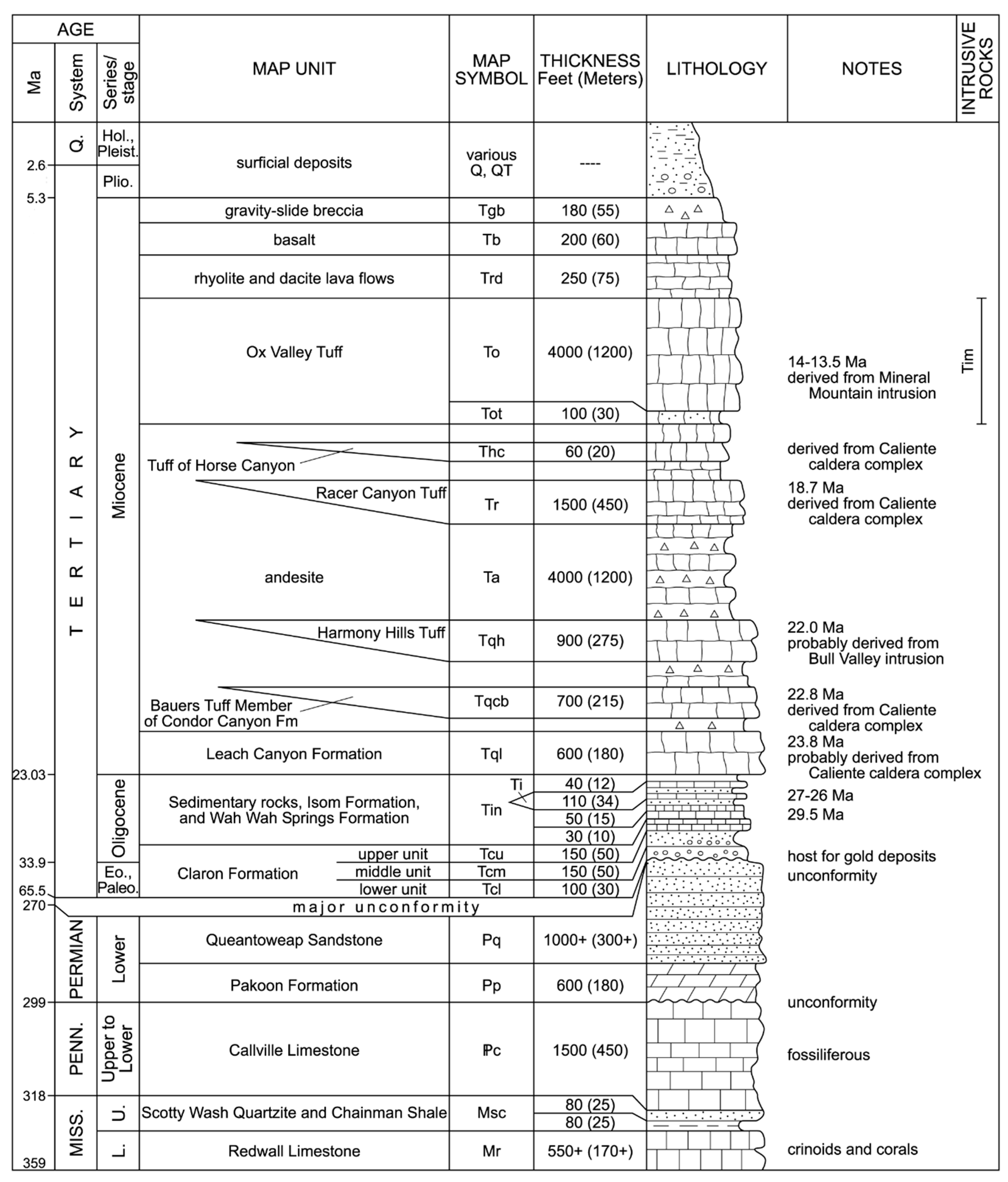

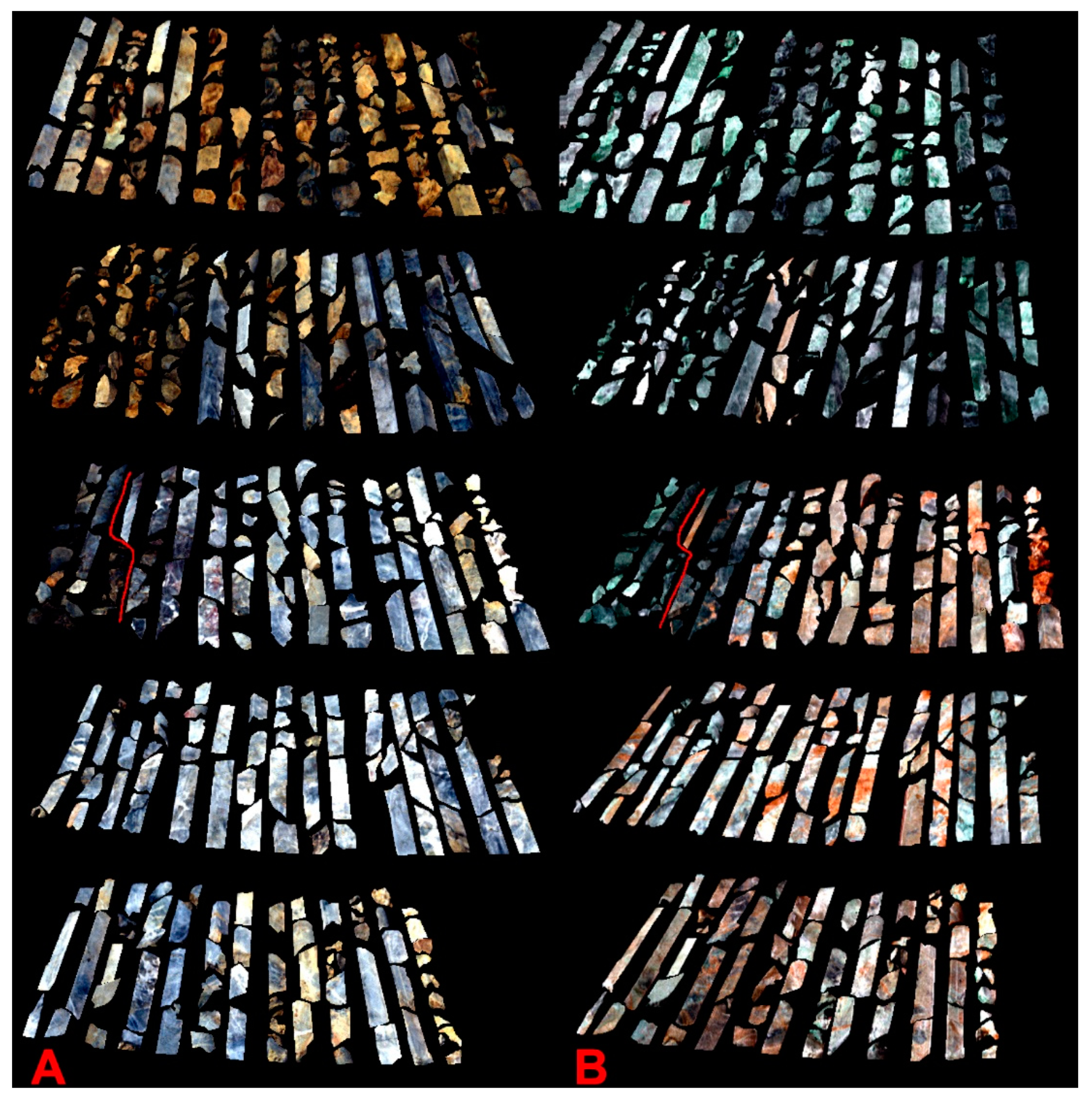
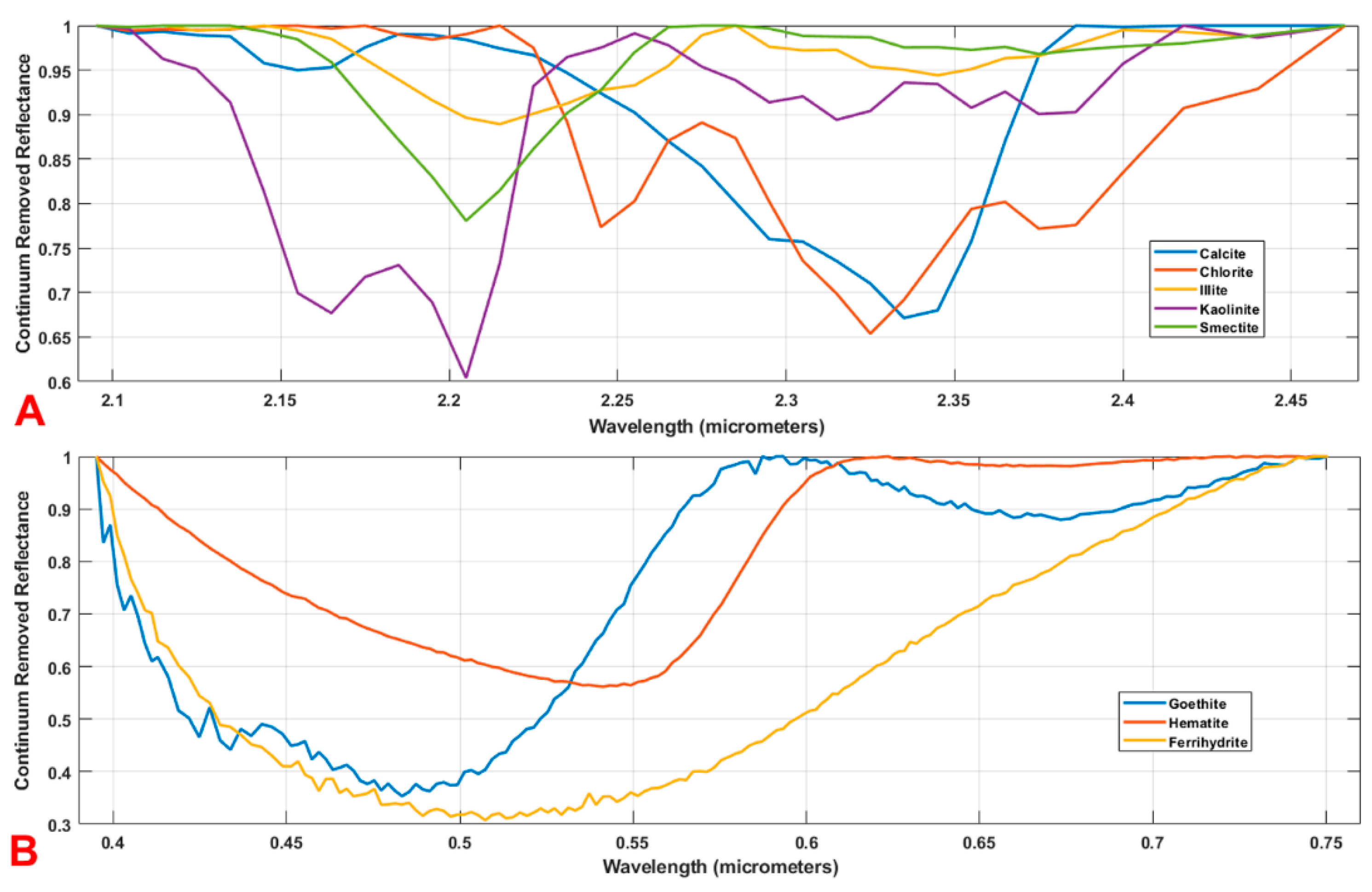

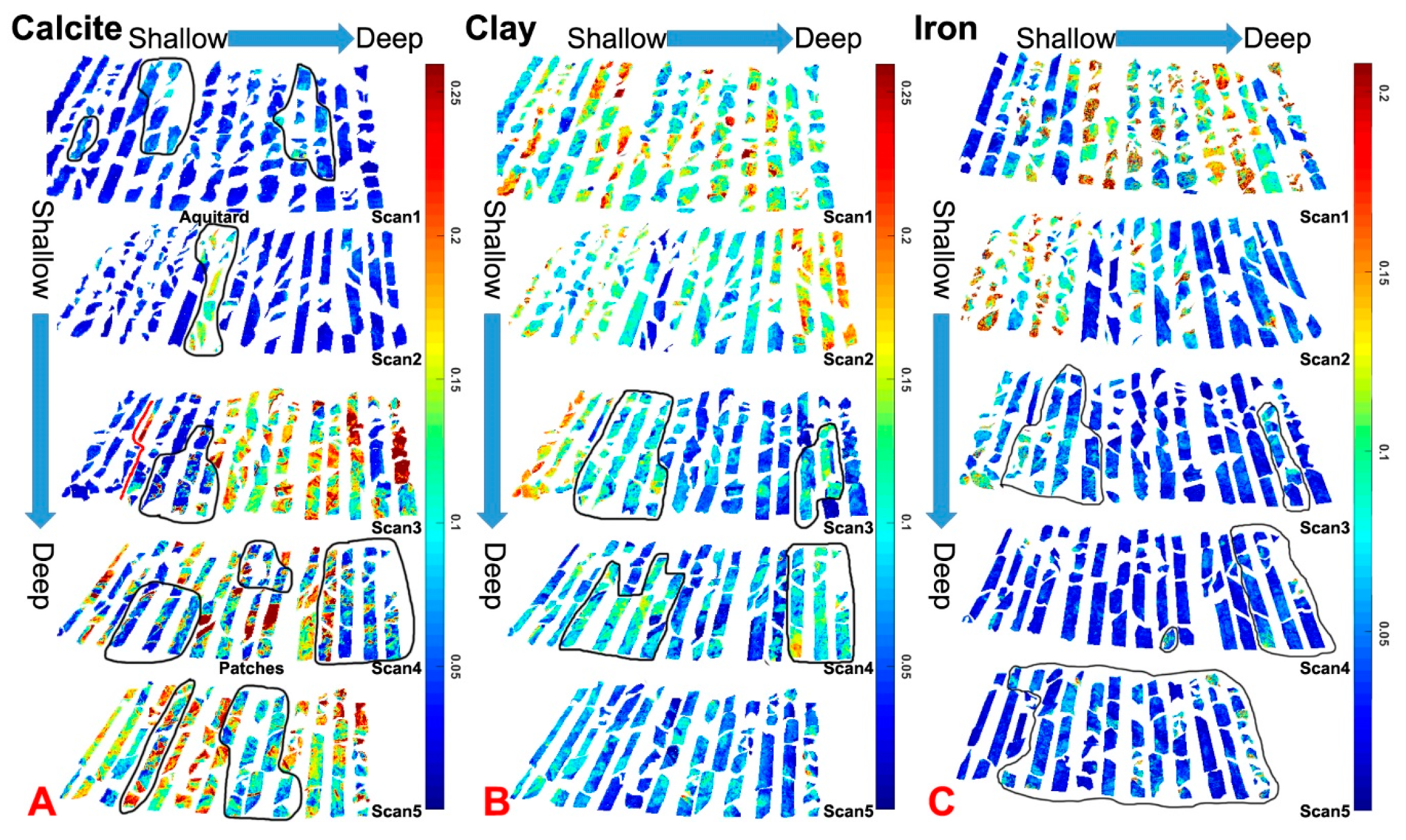
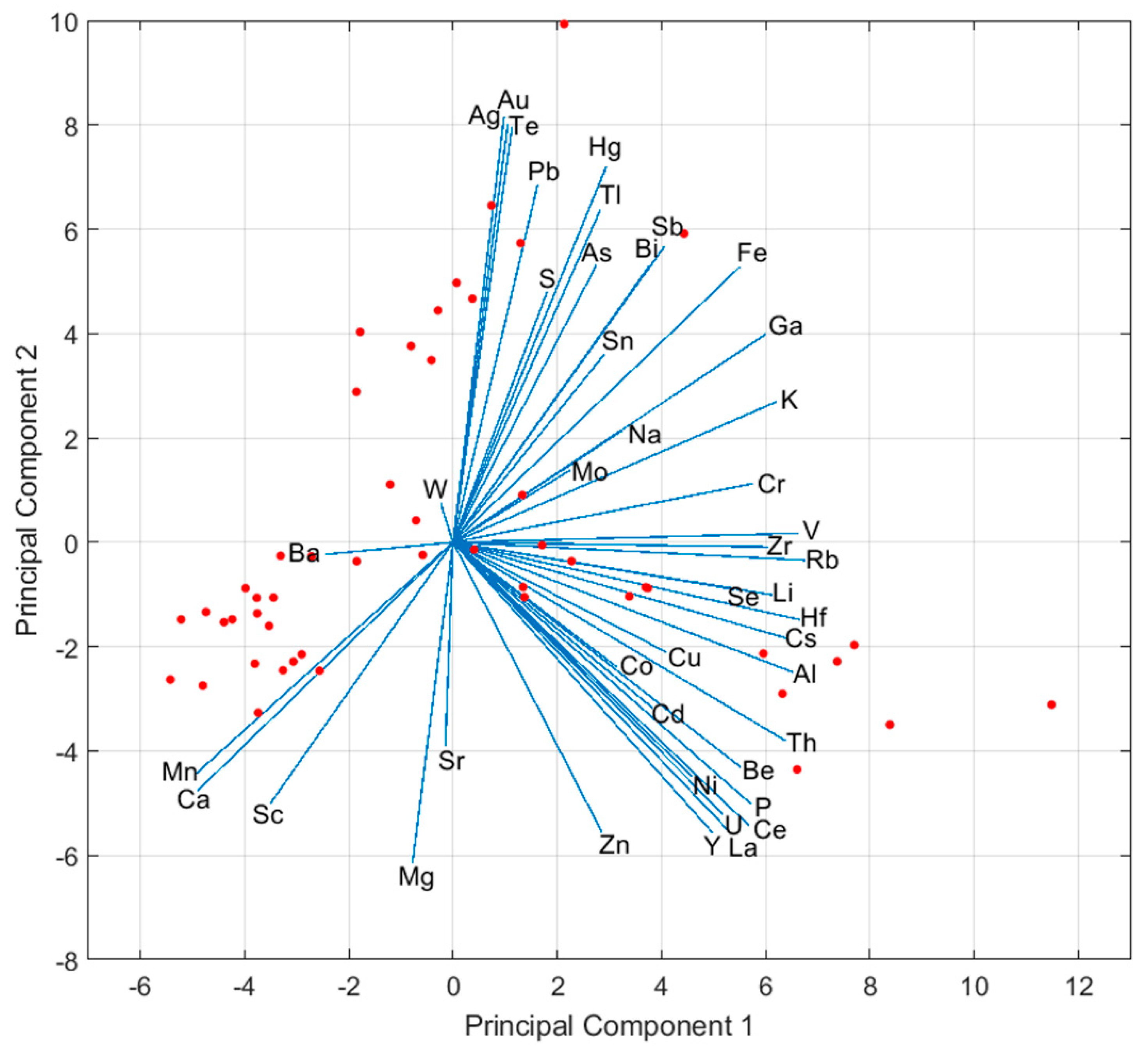
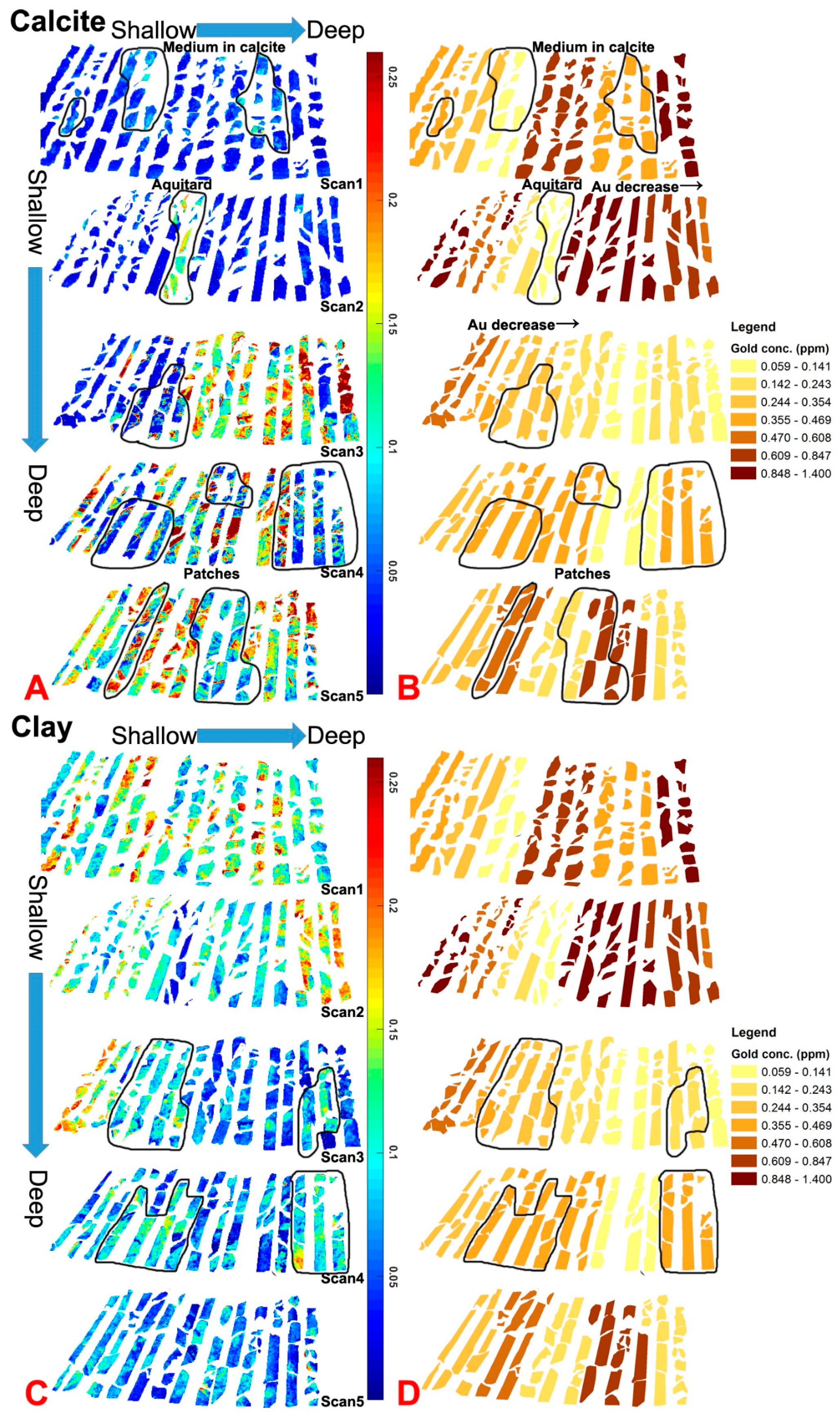


© 2019 by the authors. Licensee MDPI, Basel, Switzerland. This article is an open access article distributed under the terms and conditions of the Creative Commons Attribution (CC BY) license (http://creativecommons.org/licenses/by/4.0/).
Share and Cite
Sun, L.; Khan, S.; Shabestari, P. Integrated Hyperspectral and Geochemical Study of Sediment-Hosted Disseminated Gold at the Goldstrike District, Utah. Remote Sens. 2019, 11, 1987. https://doi.org/10.3390/rs11171987
Sun L, Khan S, Shabestari P. Integrated Hyperspectral and Geochemical Study of Sediment-Hosted Disseminated Gold at the Goldstrike District, Utah. Remote Sensing. 2019; 11(17):1987. https://doi.org/10.3390/rs11171987
Chicago/Turabian StyleSun, Lei, Shuhab Khan, and Peter Shabestari. 2019. "Integrated Hyperspectral and Geochemical Study of Sediment-Hosted Disseminated Gold at the Goldstrike District, Utah" Remote Sensing 11, no. 17: 1987. https://doi.org/10.3390/rs11171987




